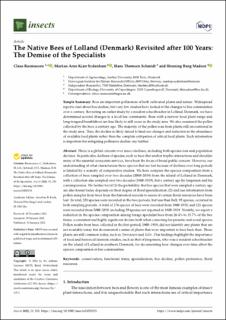| dc.description.abstract | There is a global concern over insect declines, including both species loss and population declines. In particular, declines of species, such as bees that anchor trophic interactions and shoulder many of the essential ecosystem services, have been the focus of broad public concern. However, our understanding of what characterizes those species that are lost because of declines over long periods is limited by a scarcity of comparative studies. We here compare the species composition from a collection of bees sampled over two decades (2000–2019) from the island of Lolland in Denmark, with a collection also sampled over two decades (1900–1919), but a century ago by Jørgensen and his contemporaries. We further test if (1) the probability that bee species that were sampled a century ago are also found today depends on their degree of floral specialization; (2) and use information from pollen samples from bees from the historical records to assess if certain floral resources have been lost. In total, 203 species were recorded in the two periods, but less than half, 92 species, occurred in both sampling periods. A total of 174 species of bees were recorded from 1900–1919, and 121 species were recorded from 2000–2019, including 29 species not reported in 1900–1919. Notably, we report a reduction in the species composition among forage specialist bees from 26.4% to 15.7% of the bee fauna, a consistent and highly significant decline both when correcting for parasitic and social species. Pollen swabs from bees collected in the first period, 1900–1919, did not identify any plants that are not available today but documented a series of plants that were important to bees back then. These plants are still common today, such as Taraxacum and Salix. Our findings highlight the importance of local and historical faunistic studies, such as that of Jørgensen, who was a resident schoolteacher on the island of Lolland in southern Denmark, for documenting how changes over time affect the species composition in bee communities. conservation; functional traits; specialization; bee decline; pollen preference; floral resources | en_US |

